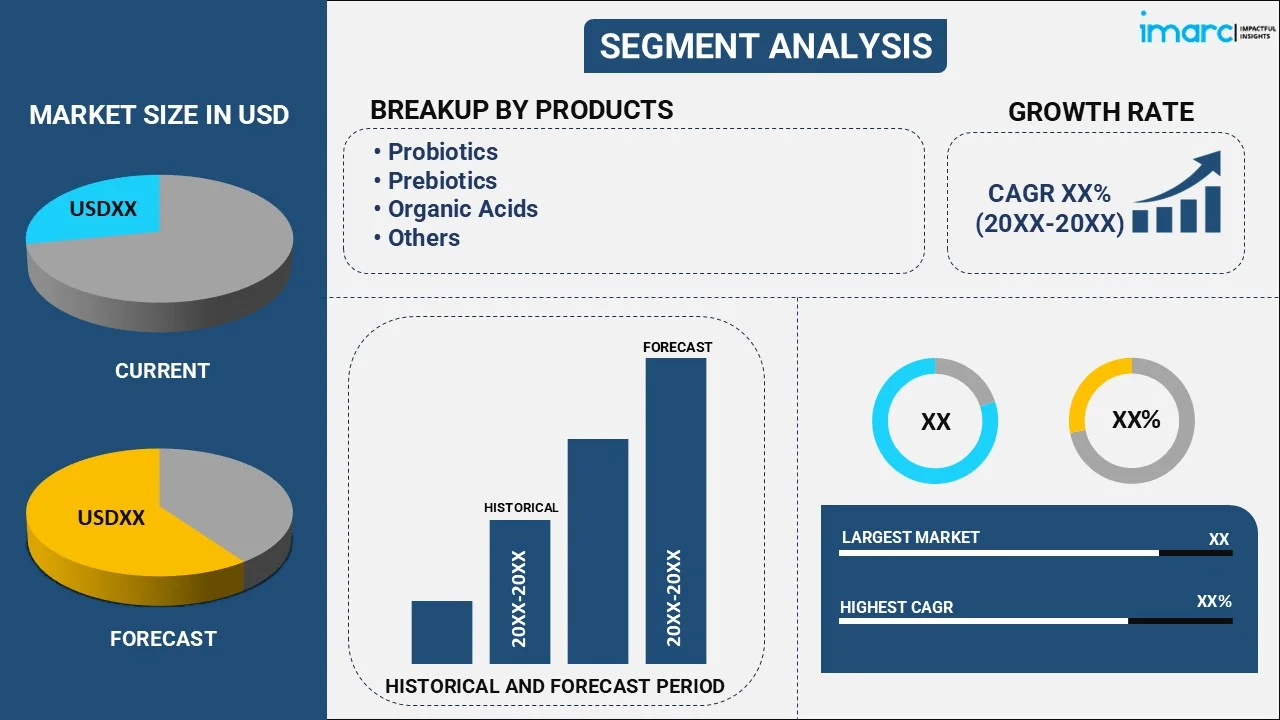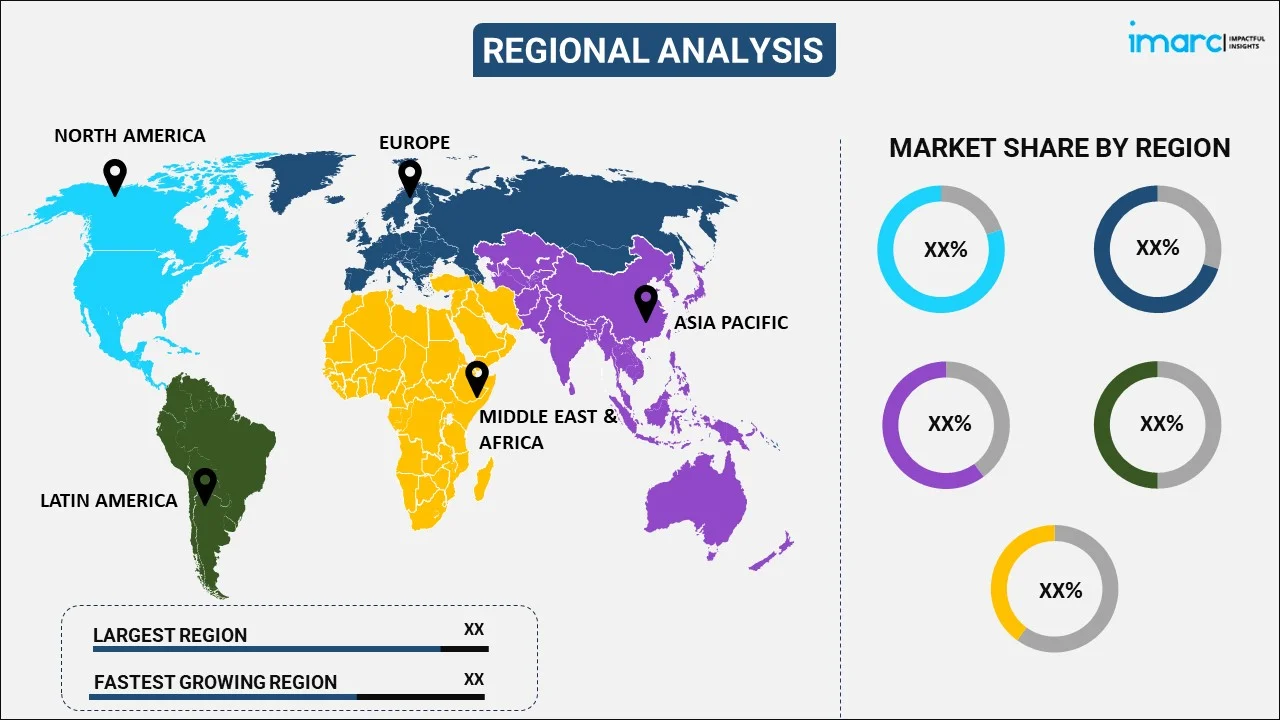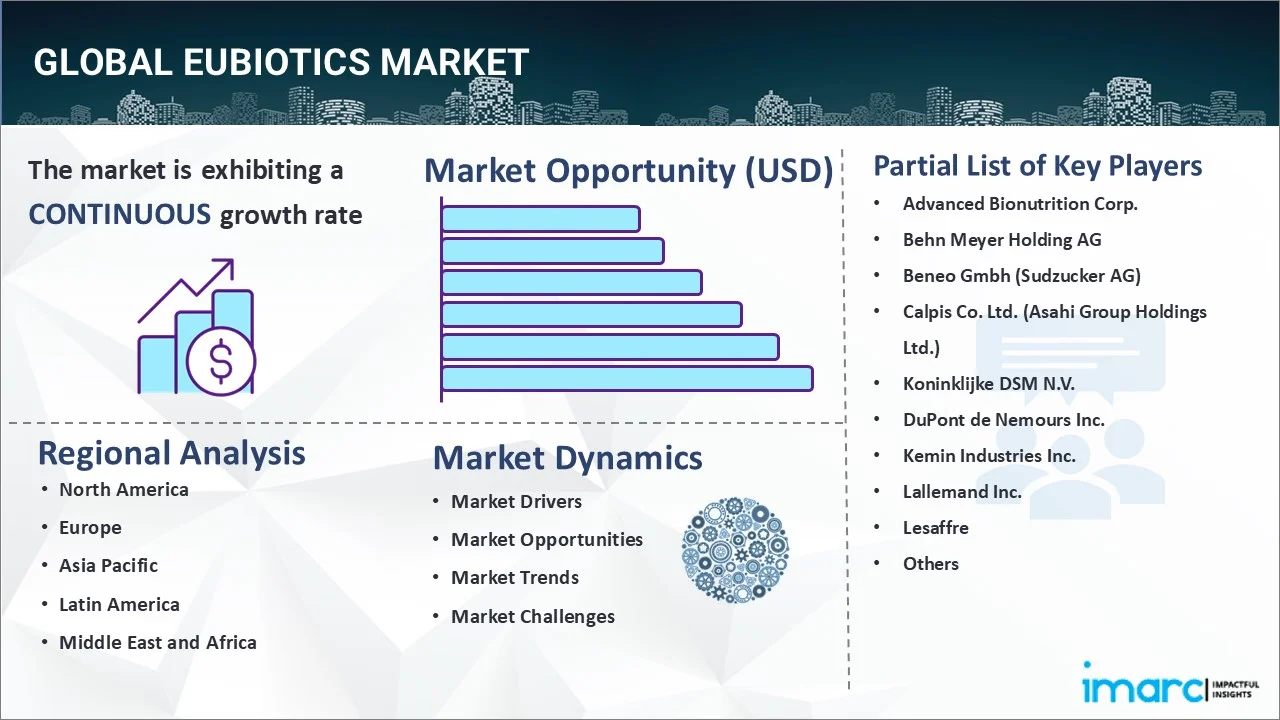
Eubiotics Market Report by Product (Probiotics, Prebiotics, Organic Acids, Essential Oils, and Others), Form (Liquid, Solid), Application (Gut Health, Immunity, Yield, and Others), End Use (Cattle Feed, Poultry Feed, Swine Feed, Aquafeed, and Others), and Region 2025-2033
Eubiotics Market Size:
The global eubiotics market size reached USD 4.9 Billion in 2024. Looking forward, IMARC Group expects the market to reach USD 8.9 Billion by 2033, exhibiting a growth rate (CAGR) of 6.26% during 2025-2033. Rising awareness of animal health and nutritional benefits of eubiotics along with rising global demand for quality livestock products are propelling eubiotics market growth. In line with this, strict regulation on antibiotic growth promoters further enhances the adoption of eubiotics in animal feed, thereby supporting its market growth.
|
Report Attribute
|
Key Statistics
|
|---|---|
|
Base Year
|
2024 |
|
Forecast Years
|
2025-2033
|
|
Historical Years
|
2019-2024
|
| Market Size in 2024 | USD 4.9 Billion |
| Market Forecast in 2033 | USD 8.9 Billion |
| Market Growth Rate (2025-2033) | 6.26% |
Eubiotics Market Analysis:
- Major Market Drivers: The global eubiotics market is mainly driven by rising awareness of gut health’s importance in livestock and the benefits of eubiotics in enhancing animal welfare and feed efficiency. Rising global demand for naturally produced meats and dairy products further stimulates the eubiotics market growth. In line with this, strict regulatory constraints on the use of antibiotics as a growth promoter in animal feed have shifted the industry focus towards eubiotics. Innovations in product development and the expansion in its applications in aquaculture and pet food are also contributing to the expansion of eubiotics market.
- Key Market Trends: Major key trends in eubiotics market include the increasing incorporation of natural and organic ingredients because of growing consumer preferences for sustainable and environmentally friendly products. There is also an increasing focus on improving the bioavailability and efficiency of eubiotics formulations through advanced technologies for example encapsulation and spore- forming probiotics. In line with this, the partnership between eubiotics manufacturers and livestock producers is expanding thereby driving global eubiotics demand. The growing use of eubiotics in aquaculture and pet nutrition is also a significant trend that is broadening the scope of applications in eubiotics market.
- Geographical Trends: Geographical trends in the eubiotics market show robust growth in Asia Pacific mainly driven by the increase in meat consumption and the rising awareness of livestock health in countries like China and India. Europe remains a strong market, stimulated by strict regulations against antibiotics in animal feed and rising demand for organic livestock products. North America is witnessing an increase in demand for natural feed additives because of consumer preferences for sustainable agriculture. Meanwhile, Latin America and Africa are also emerging as a potential market with their rapidly growing livestock sectors and increase in agricultural productivity.
- Competitive Landscape: Some of the major market players in the eubiotics industry include Advanced Bionutrition Corp., Behn Meyer Holding AG, Beneo Gmbh (Südzucker AG), Calpis Co. Ltd. (Asahi Group Holdings Ltd.), Koninklijke DSM N.V., DuPont de Nemours Inc., Kemin Industries Inc., Lallemand Inc., Lesaffre, Novus International Inc. (Mitsui & Co. Ltd.) and UAS Laboratories LLC (Chr. Hansen Holding A/S)., among many others.
- Challenges and Opportunities: The global eubiotics market faces various challenges, including high production costs and strict regulatory barriers, which in turn slow down product approvals and market entry. In line with this, there is a lack of awareness about the benefits of eubiotics in emerging markets which restrains its adoption. However, these challenges also present significant opportunities. There is a growing opportunity for eubiotics market growth through education and a rise in awareness programs about animal health and nutrition benefits. Advancements in research and development (R&D) can lead to more cost-effective and efficient products. Furthermore, growing markets in Asia, Latin America, and Africa offer new opportunities for market penetration because of their growing agricultural sectors and rising focus on animal health.
Eubiotics Market Trends:
Rising Demand for Natural Products
The gradual shift towards natural and non-antibiotic alternatives in animal feed is mainly driven by the rising concerns about antibiotic resistance which is a significant public health issue. According to a report published by the Centers for Disease Control and Prevention, antibiotic resistance is one of the top threats to public health. In the United States, antibiotic resistance causes more than 2 million infections and 23,000 deaths per year. Eubiotics mainly comprising probiotics, prebiotics and organic acids offer a great alternative to antibiotics. Eubiotics help enhance gut health and bolster the immune system in livestock without contributing to antibiotic resistance. Its ability to improve animal health and performance sustainability is positioning eubiotics as an important component in the future of animal husbandry and feed formulations.
Increase in Regulatory Support
Governments globally are increasingly implementing strict regulations on antibiotic use in animal agriculture to combat the growing threat of antibiotic resistance. These regulations aim to limit the routine use of antibiotics that can promote resistance among bacteria. In 2017, the FDA prohibited the use of antibiotics for growth promotion in animals. The antibiotic drugs could only be obtained with a veterinarian's prescription, no longer over the counter. Such regulatory measures are driving the demand for alternative solutions like eubiotics, which include probiotics, prebiotics, and organic acids that naturally enhance animal health and performance without contributing to antibiotic resistance. This regulatory environment supports a shift toward more sustainable and responsible animal farming practices, thereby driving eubiotics market growth.
Expansion in Emerging Markets
As emerging markets in Asia-Pacific, Latin America, and some parts of Africa experience rapid modernization and gradual growth in their agricultural sectors, there's a marked increase in the adoption of advanced animal feed solutions like eubiotics. This growth is particularly evident in livestock production and aquaculture, where the need for sustainable and efficient practices is becoming increasingly important. According to a report published by the Department of Animal Husbandry and Dairying, there are about 303.76 million bovines (cattle, buffalo, mithun, and yak), 74.26 million sheep, 148.88 million goats, 9.06 million pigs, and about 851.81 million poultry as per 20th Livestock Census in the country. Eubiotics, known for enhancing gut health and improving overall animal immunity, are being adopted as essential components of animal nutrition programs, which in turn is propelling the eubiotics demand.
Eubiotics Market Segmentation:
IMARC Group provides an analysis of the key trends in each segment of the market, along with forecasts at the global, regional, and country levels for 2025-2033. Our report has categorized the market based on product, form, application and end-use.
Breakup by Product:

- Probiotics
- Prebiotics
- Organic Acids
- Essential Oils
- Others
Probiotics accounts for the majority of the market share
The report has provided a detailed breakup and analysis of the market based on the product. This includes probiotics, prebiotics, organic acids, essential oils, and others. According to the report, prebiotics represented the largest segment.
Probiotics hold a significant majority of the eubiotics market share, primarily due to their well-documented benefits in promoting gut health and enhancing immunity in livestock. The effectiveness of probiotics in improving feed conversion ratios, increasing growth rates, and reducing disease incidence has been widely recognized by the livestock industry. As regulatory pressures mount against the use of antibiotics, probiotics are increasingly viewed as a viable, natural alternative. The EU banned routine use of antibiotics for animals and restricted preventative use in January 2022. The UK had planned to align with the EU regulations and now commits to "similar provisions" in its 5-year action plan update. Continuous innovations in probiotic strains and delivery methods also support their market dominance.
Breakup by Form:
- Liquid
- Solid
Solid holds the largest share of the industry
A detailed breakup and analysis of the market based on the Form have also been provided in the report. This includes liquid, and solid. According to the report, solid accounted for the largest market share.
Solid eubiotics are the most popular form in the eubiotics industry due to their ease of handling, stability, and longer shelf life. They are preferred for their convenience in storage and transportation, and for their ability to withstand varying environmental conditions without losing their effectiveness. Manufacturers prefer producing solid eubiotics because they can be easily mixed with other feed components, ensuring uniform distribution in feed. This form is widely adopted across various types of livestock feed, further consolidating their dominant market position.
Breakup by Application:
- Gut Health
- Immunity
- Yield
- Others
Gut Health represents the leading market segment
The report has provided a detailed breakup and analysis of the market based on the application. This includes gut health, immunity, yield, and others. According to the report, git health represented the largest segment.
Gut health represents the leading market segment within the eubiotics industry, driven by the critical role that gut microbiota plays in overall animal health and productivity. Eubiotics such as probiotics, prebiotics, and organic acids are extensively utilized to enhance gut flora, improve digestion, and boost immune responses in livestock. This segment's dominance is underscored by increasing evidence linking gut health to better feed efficiency, reduced disease incidence, and enhanced growth performance in animals. As producers continue to seek natural solutions for maintaining animal health, particularly in the face of restrictions on antibiotic growth promoters, the focus on gut health solutions is expected to sustain robust market growth in this segment.
Breakup by End-Use:
- Cattle Feed
- Poultry Feed
- Swine Feed
- Aquafeed
- Others
Poultry Feed exhibits a clear dominance in the market
A detailed breakup and analysis of the market based on the end-use have also been provided in the report. This includes cattle feed, poultry feed, swine feed, aquafeed, and others. According to the report, poultry feed accounted for the largest market share.
Poultry feed exhibits clear dominance in the eubiotics market, primarily because poultry is one of the most widely farmed animals globally, driven by rising consumer demand for poultry meat and eggs. The intensive nature of poultry farming necessitates robust health management practices, where eubiotics play a crucial role in enhancing gut health and preventing disease. The use of eubiotics in poultry feed not only improves feed conversion rates and growth performance but also supports the industry's shift away from antibiotic growth promoters. Additionally, with the global expansion of poultry production, particularly in emerging markets, the demand for eubiotics in poultry feed is expected to continue growing, reinforcing its dominant position in the market.
Breakup by Region:

- North America
- United States
- Canada
- Asia Pacific
- China
- Japan
- India
- South Korea
- Australia
- Indonesia
- Others
- Europe
- Germany
- France
- United Kingdom
- Italy
- Spain
- Russia
- Others
- Latin America
- Brazil
- Mexico
- Others
- Middle East and Africa
Europe leads the market, accounting for the largest eubiotics market share
The report has also provided a comprehensive analysis of all the major regional markets, which include North America (the United States and Canada); Europe (Germany, France, the United Kingdom, Italy, Spain, Russia, and others); Asia Pacific (China, Japan, India, South Korea, Australia, Indonesia, and others); Latin America (Brazil, Mexico, and others); and the Middle East and Africa. According to the report, Europe represents the largest regional market for eubiotics.
Europe leads the eubiotics market due to its strict regulations against antibiotics in animal feed. The region promotes animal welfare and food safety by encouraging the use of natural alternatives, driving demand for eubiotics. In addition, European consumers are highly aware of sustainable and ethical animal farming practices. Europe's advanced agricultural technologies and significant investments in research and development of feed additives also contribute to its market leadership. Horizon Europe, with a budget of €95.5 billion, is Europe's primary funding program for research and innovation. These factors make Europe both a significant consumer and innovator in the eubiotics sector.
Competitive Landscape:
- The market research report has also provided a comprehensive analysis of the competitive landscape in the market. Detailed profiles of all major companies have also been provided. Some of the major market players in the eubiotics industry include Advanced Bionutrition Corp., Behn Meyer Holding AG, Beneo Gmbh (Südzucker AG), Calpis Co. Ltd. (Asahi Group Holdings Ltd.), Koninklijke DSM N.V., DuPont de Nemours Inc., Kemin Industries Inc., Lallemand Inc., Lesaffre, Novus International Inc. (Mitsui & Co. Ltd.) and UAS Laboratories LLC (Chr. Hansen Holding A/S), etc.
(Please note that this is only a partial list of the key players, and the complete list is provided in the report.)
- Key players in the eubiotics market are expanding their product offerings to meet the diverse livestock and pet nutrition needs, including specialized formulations tailored to specific health issues. To stand out, they are also providing value-added services such as customized feeding plans and technical support. For example, Novus International launches the Scale Up™ program for Sows at PorciFORUM 2023 in Spain, aiming to optimize sow lifetime productivity and achieve more meat per sow lifetime through improved reproductive performance and sow health. Furthermore, the use of digital tools for customer engagement is also enhancing user experiences, making it easier to access product information, receive consultations, and make purchases with ease.
Eubiotics Market News:
- In 2022, Lesaffre, a global leader in fermentation, has acquired Recombia Biosciences, a biotechnology company specializing in high-throughput genome editing and synthetic biology. The acquisition is part of Lesaffre's strategy to invest heavily in research and development to accelerate innovation in yeast development and production.
- In 2024, Novus International, Inc. finalized the acquisition of BioResource International, Inc. (BRI), gaining ownership of BRI's products, intellectual property, and facilities, aiming to enhance its innovation pipeline and better serve customers.
Eubiotics Market Report Scope:
| Report Features | Details |
|---|---|
| Base Year of the Analysis | 2024 |
| Historical Period | 2019-2024 |
| Forecast Period | 2025-2033 |
| Units | Billion USD |
| Scope of the Report | Exploration of Historical Trends and Market Outlook, Industry Catalysts and Challenges, Segment-Wise Historical and Future Market Assessment:
|
| Products Covered | Probiotics, Prebiotics, Organic Acids, Essential Oils, Others |
| Forms Covered | Liquid, Solid |
| Applications Covered | Gut Health, Immunity, Yield, Others |
| End-Uses Covered | Cattle Feed, Poultry Feed, Swine Feed, Aquafeed, Others |
| Regions Covered | Asia Pacific, Europe, North America, Latin America, Middle East and Africa |
| Countries Covered | United States, Canada, Germany, France, United Kingdom, Italy, Spain, Russia, China, Japan, India, South Korea, Australia, Indonesia, Brazil, Mexico |
| Companies Covered | Advanced Bionutrition Corp., Behn Meyer Holding AG, Beneo Gmbh (Sudzucker AG), Calpis Co. Ltd. (Asahi Group Holdings Ltd.), Koninklijke DSM N.V., DuPont de Nemours Inc., Kemin Industries Inc., Lallemand Inc., Lesaffre, Novus International Inc. (Mitsui &Co. Ltd.), UAS Laboratories LLC (Chr. Hansen Holding A/S), etc. |
| Customization Scope | 10% Free Customization |
| Post-Sale Analyst Support | 10-12 Weeks |
| Delivery Format | PDF and Excel through Email (We can also provide the editable version of the report in PPT/Word format on special request) |
Key Questions Answered in This Report:
- How has the global eubiotics market performed so far, and how will it perform in the coming years?
- What are the drivers, restraints, and opportunities in the global eubiotics market?
- What is the impact of each driver, restraint, and opportunity on the global eubiotics market?
- What are the key regional markets?
- Which countries represent the most attractive eubiotics market?
- What is the breakup of the market based on the product?
- Which is the most attractive product in the eubiotics market?
- What is the breakup of the market based on the form?
- Which is the most attractive form in the eubiotics market?
- What is the breakup of the market based on the application?
- What is the most attractive application in the eubiotics market?
- What is the breakup of the market based on the end-use?
- Which is the most attractive end-use segment in the eubiotics market?
- What is the breakup of the market based on the Region?
- Which region represents the most attractive eubiotics market?
- What is the competitive structure of the market?
- Who are the key players/companies in the global eubiotics market?
Key Benefits for Stakeholders:
- IMARC’s industry report offers a comprehensive quantitative analysis of various market segments, historical and current market trends, market forecasts, and dynamics of the eubiotics market from 2019-2033.
- The research report provides the latest information on the market drivers, challenges, and opportunities in the global eubiotics market.
- The study maps the leading, as well as the fastest-growing, regional markets. It further enables stakeholders to identify the key country-level markets within each region.
- Porter's five forces analysis assists stakeholders in assessing the impact of new entrants, competitive rivalry, supplier power, buyer power, and the threat of substitution. It helps stakeholders to analyze the level of competition within the eubiotics industry and its attractiveness.
- The competitive landscape allows stakeholders to understand their competitive environment and provides insight into the current positions of key players in the market.
Need more help?
- Speak to our experienced analysts for insights on the current market scenarios.
- Include additional segments and countries to customize the report as per your requirement.
- Gain an unparalleled competitive advantage in your domain by understanding how to utilize the report and positively impacting your operations and revenue.
- For further assistance, please connect with our analysts.


 Inquire Before Buying
Inquire Before Buying
 Speak to an Analyst
Speak to an Analyst
 Request Brochure
Request Brochure
 Request Customization
Request Customization



.webp)




.webp)












